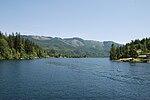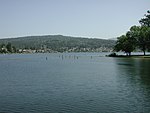Galbraith Mountain
Geography of Bellingham, WashingtonMountains of Washington (state)Mountains of Whatcom County, Washington

Galbraith Mountain is the common name for North Lookout Mountain, located between the communities of Sudden Valley and Bellingham, Washington. It has been rated the best mountain bike trail system in the state of Washington. Galbraith Mountain is located between Lake Padden and Lake Whatcom. Over 65 miles of singletrack winds through 3,000 acres overlooking the city of Bellingham and Bellingham Bay. The mountain is accessible to all non-motorized use; all of the trails are built and maintained by the WMBC.
Excerpt from the Wikipedia article Galbraith Mountain (License: CC BY-SA 3.0, Authors, Images).Galbraith Mountain
LM-2000 Road,
Geographical coordinates (GPS) Address Nearby Places Show on map
Geographical coordinates (GPS)
| Latitude | Longitude |
|---|---|
| N 48.688611111111 ° | E -122.36083333333 ° |
Address
LM-2000 Road
98228
Washington, United States
Open on Google Maps







